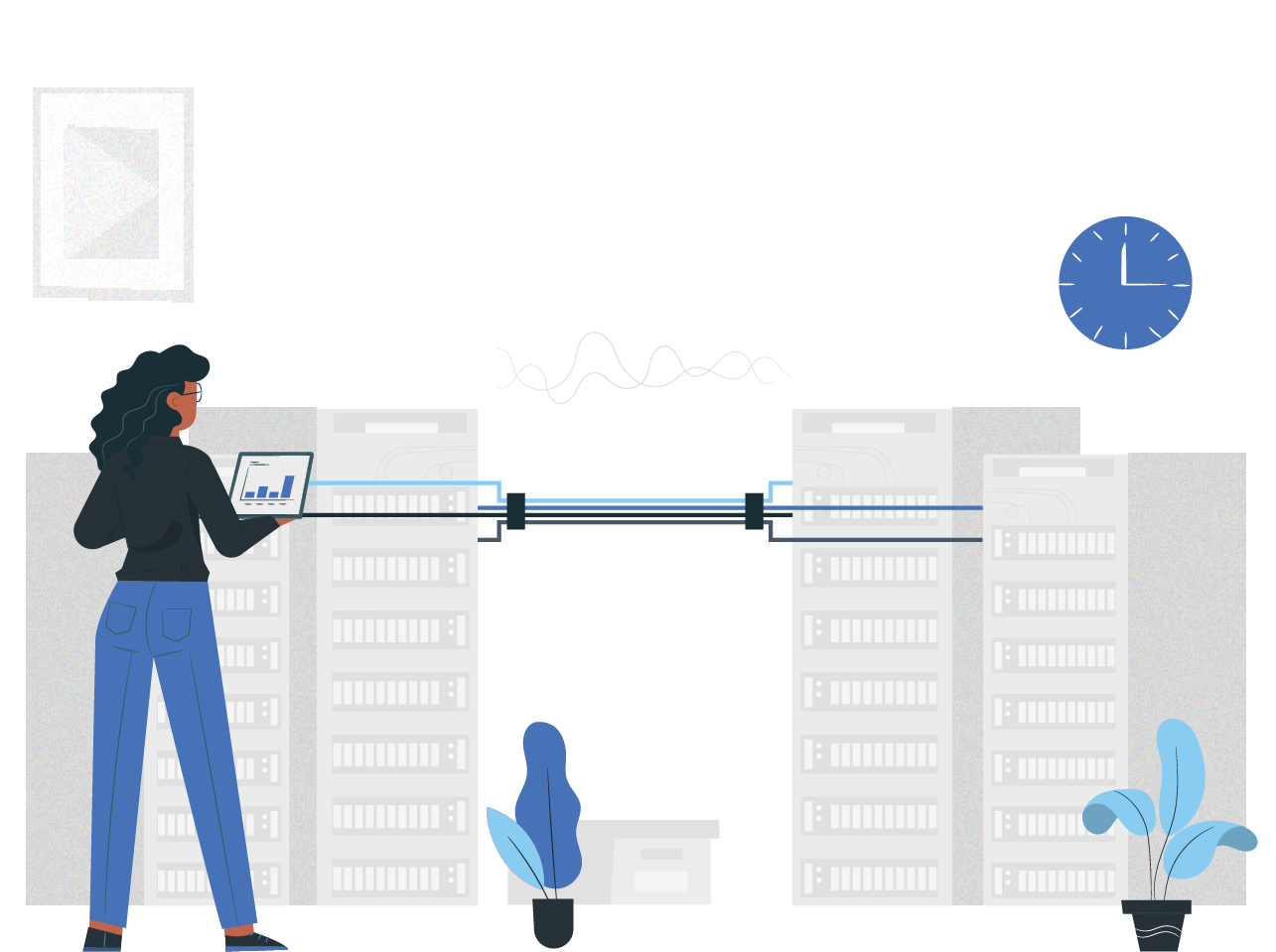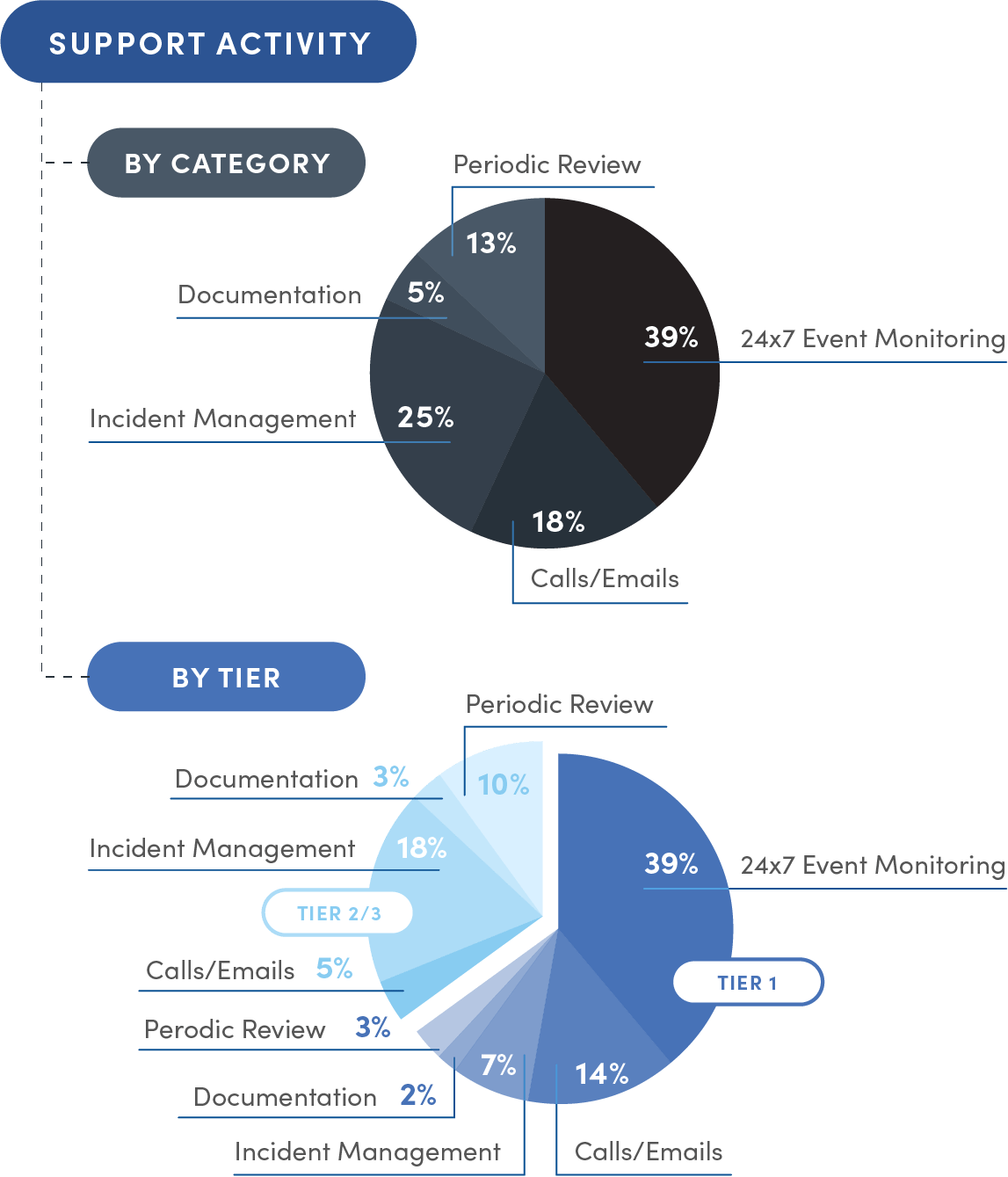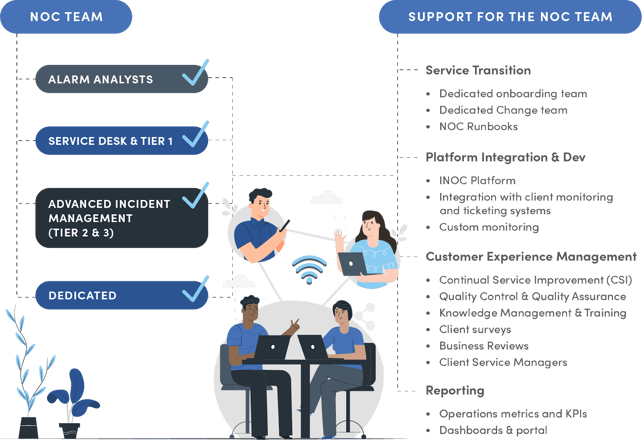.png?width=1273&name=imageonline-co-roundcorner%20(1).png)
Network Design and Architecture
While the specifics of enterprise network design are totally dependent on the organization it's built for, that architecture should be robust, flexible, and scalable no matter what it’s comprised of.
Let’s unpack those a bit:
Robustness
To be robust, the network should be designed to handle all types of traffic and bandwidth requirements. One best practice is to segment the network, which can prevent bottlenecks and protect sensitive areas.
- One way to do this is by implementing Virtual LANs (VLANs) that group devices based on their function or location. For example, a finance department's devices can be grouped together in a VLAN, separate from those used by the marketing department to prevent bottlenecks and protect sensitive areas of the network.
Ensuring fault tolerance in network design is another critical aspect of a robust network. This can be achieved by implementing failover systems or redundant paths to maintain network availability during component failures.
- RAID configurations in storage systems are one common example of this in practice—allowing data to be distributed across multiple drives so if one drive fails, the system can still continue functioning without data loss.
- Another example is using redundant power supplies for critical networking equipment, ensuring that a single power supply failure doesn't bring down the entire network.
Flexibility
To be flexible, the network should be adaptable to changing business needs and technological advancements.
Flexible network design can be enhanced using hybrid network models, incorporating both on-premises and cloud-based resources. This allows for quickly and efficiently shifting resources and workloads as needed.
For example, enterprises often run their customer-facing applications in a public cloud for better scalability and cost-efficiency while keeping sensitive data and critical business applications in an on-premises data center for better control and security.
Network Function Virtualization can also enhance network flexibility by decoupling network functions from specific hardware, allowing for more flexibility in how services are deployed and managed.
- For example, deploying a virtual firewall as an NFV. Rather than being tied to a specific hardware device, the firewall can be deployed wherever needed in the network, providing flexible protection that can be easily moved or scaled as requirements change.
Scalability
To be scalable, the network should be capable of handling increasing amounts of work and accommodating growth without impacting performance or quality.
Embracing scalable solutions like software-defined networking (SDN) is important to accommodate future growth. Enterprises can utilize cloud services that offer virtual network functions (VNFs) that can be easily deployed and managed. SDN also enables enterprises to automate network provisioning and configuration with software that abstracts the underlying hardware, making it easier to manage and scale network components across different geographic locations and cloud platforms.
Another way to improve scalability is by implementing elastic infrastructure in your network design. Elasticity allows the network to expand and contract based on demand, ensuring it can handle growth without compromising performance. Cloud-based services like Amazon Web Services (AWS) or Google Cloud Platform (GCP) offer elastic load balancing, automatically distributing incoming application traffic across multiple resources, allowing for seamless scalability in response to changing demand.
Containerization is also important for scalability. Containers can be quickly deployed, scaled, or removed as needed, making it easier to adjust network capacity in response to fluctuating demand.
💡 INOC recommends
First, design with future expansion and ease of upgrade in mind from the start. In 2025, we’re witnessing a new era of network management where future expansion and ease of upgrade aren’t just desirable—they’re necessary. Too often, we encounter networks built to meet a set of immediate needs with little consideration for future growth, leading to numerous challenges when scaling or upgrading their network infrastructure.
Given an uncertain future where problems like shipping delays and other logistical issues may be more common, it's important to 'future-proof' your network at the design stage. Guide your decisions to allow your network to accommodate emerging technologies and increasing capacity demands—saving time, money, and effort in the long run.
Second, design around how enterprise networks are evolving. Enterprise networking has transformed significantly over the years. In the past, enterprise network design revolved around physical connectivity—linking sites and managing servers, workstations, and printers within these sites. Today, however, we are dealing with a dynamic mix of corporate-owned and personally-owned devices, most of which are connected wirelessly.
And the rise of remote work means most employees are no longer based in an office, shifting the focus of enterprise networking to accommodate remote connectivity reliably and securely. This means considering VPNs and ensuring robust internal and external infrastructure to support users, whether they're in the office or at home. It's also about dealing with issues like regional internet outages, which can significantly impact business.
Monitoring and management have also evolved. You're no longer just keeping an eye on corporate devices but also personally owned devices on the Wi-Fi network. Thus, the question of what you are designing for and how you monitor it has fundamentally changed in just the past five years.
In light of these changes, there is a clear need for better planning during the initial stages of network design. This involves not only considering the current demands on the network but also anticipating future needs and growth. If you're lucky enough to be working in a greenfield environment, take the time to understand the modalities of work and ensure the network supports them while still maintaining necessary security paradigms.
Part of this planning involves considering your growth pattern. It may be worth considering using services rather than physical infrastructure to allow dynamic scaling and bypass issues with hardware availability. For example, leveraging a service out of AWS for VPN connections can be more flexible than relying on physical infrastructure in your data center. Although this may initially cost more, the ability to scale up or down based on your business needs can be invaluable.
While it may seem less expensive to continue using physical infrastructure in your data center, such a decision might limit your flexibility and ability to respond to changing demands. Recognizing these shifts in enterprise network design can help ensure your organization's network remains robust, flexible, and scalable well into the future.
Network Monitoring and Performance Management
Network monitoring and performance management are critical elements of enterprise network management. In 2024, the approach to these areas combines traditional tools and cutting-edge, AIOps-driven technologies, offering a layered and nuanced understanding of network behavior and performance.
Network monitoring
Traditional network monitoring tools, such as SNMP managers, network protocol analyzers, and network mapping tools, continue to provide real-time metrics and alerts that help administrators identify and troubleshoot issues quickly.
For instance, SNMP managers collect information from various network devices, providing a global view of the network's health. Network protocol analyzers, on the other hand, help to inspect traffic at a granular level, allowing administrators to identify anomalies and possible security threats. Network mapping tools offer a visual representation of the network, making it easier to understand its structure and identify failure points.
And while these traditional tools remain fundamental, they’re being enhanced by advanced AIOps capabilities. (AIOps employs machine learning to analyze large volumes of network data, proactively identify potential issues, predict their impact, and sometimes autonomously rectify them before they degrade network performance). Applying AIOps leads to faster incident resolution, improved efficiency, and reduced downtime.
In another guide, INOC’s Ben Cone explored a few best practices for enterprise network monitoring in particular, pointing out a few elements that are critical today, such as:
- mastering today’s protocols;
- marrying disparate data points to unlock deeper insights, and
- establishing a holistic view of the network environment to facilitate improved coordination across departments, thus minimizing organizational challenges and enhancing problem-solving.
Performance management
Performance management tools, such as Application Performance Management (APM) software, should be employed to closely monitor how well the network serves end-users and applications. APM tools can monitor network activity, analyze performance data, and provide insights for improvement, ensuring the network delivers an optimal user experience.
By combining these traditional and advanced tools and techniques, enterprises can achieve a more dynamic and proactive approach to network monitoring and performance management.
This combination helps maintain high network uptime and ensure a seamless user experience. It's essential to regularly update monitoring parameters and performance management strategies to keep pace with changing network conditions and business requirements. As network environments continue to grow more complex and dynamic, these practices will remain critical to successful network management.
💡 INOC recommends
First, recognize the growing importance of data in managing a network. From a performance management perspective, the role of data has grown significantly. In an era where more data equates to more insights, companies are increasingly focusing on capturing and analyzing every data point. Using third-party tools or custom-developed ones can enable us to gather insights that can arm clients to make informed decisions and have insightful conversations with their providers.
Take chronic or problem management, for instance. INOC’s Director of Advanced Technical Services, Austin Kelly, recounted how analyzing performance data allowed his team to spot when network links were under strain through a specific provider. By providing this information to their clients in the form of monthly average totals, they could negotiate with their provider to resolve long-standing chronic issues and even seek financial compensation.
Another example Austin cited was how the team pinpointed a chronic issue where a train's daily passage was causing excessive vibrations on a fiber run, leading to service interruptions. The wealth of data they collected led them to this conclusion and, ultimately, to a solution. As Austin succinctly put it, "The more data you have, the more apt you are to identify where issues are and where they're occurring."
Second, rethink your approach to network monitoring. When it comes to network monitoring, the team at INOC doesn't just rely on raw alerts from devices. As INOC’s VP of technology, Jim Martin puts it, "Monitoring is more than just the raw alerts off of devices because that's only giving you a piece of the puzzle." Jim emphasizes that understanding the business impact of a malfunctioning device or port is essential to prioritize the resolution process effectively. It's about comprehending the overall situation and severity, not just noting that there is an issue.
INOC's approach to network monitoring and performance management is about understanding the 'why' behind the alerts and the level of impact they could have on the business. In Jim's words, "Companies always have the alarms that tell them what's happening. We provide the additional context of why you should care and how much you should care."
Network Maintenance and Support
Effective network maintenance and support requires companies to take a proactive approach to detect and resolve issues before they impact business operations. To ensure that the network is always running optimally, enterprises need to conduct regular network audits, software updates, hardware maintenance, and troubleshooting.
An important component of modern network support is 24x7 monitoring by a NOC, which can swiftly respond to incidents at any time. With the help of AIOps, many routine maintenance tasks are now augmented or automated, freeing up IT teams to focus on strategic initiatives. Additionally, enterprises can provide resources like knowledge bases to help their employees resolve issues faster and more accurately with fewer escalations.
💡 INOC recommends
Focus on communication basics that often get missed. INOC’s Austin Kelly highlights how fundamental basic communications is to effective network maintenance and support.
“So much time is wasted 'chasing ghosts' due to poor communication. For instance, if a customer is relocating equipment and fails to notify the (NOC, it leads to a cascade of false alarms and needless time wasted for all involved. An hour and a half of a NOC's time, an hour and a half of a high-level resource for the client, all could be saved with a simple email notification. This is a frequent occurrence and is a significant time sink in today's maintenance landscape.”
The cost of such issues is often not immediately apparent. The financial implication is more nuanced and harder to measure. For Austin, it’s about considering the opportunity cost of what could have been achieved during the time wasted. Valuable resources are diverted away from enhancing and improving services because they're consumed in resolving false alarms.
One way to plan improvements here is to look to sectors where this aspect of network maintenance and support is well managed. Federal agencies, for example, tend to have robust change control measures in place. Before any changes are made, they undergo thorough reviews, with notifications sent to all relevant parties and meticulous documentation maintained. High-end financial institutions, including high-frequency traders and big-name banks, also have stringent change control procedures. In both these sectors, everyone is kept informed, and change is handled in a structured, predictable manner, minimizing unexpected disruptions.
Companies can learn from these examples and implement similar stringent change control measures to improve their network maintenance and support.
Operational Challenges of Enabling These Strategies
Enabling these network strategies present several operational challenges that IT teams must overcome:
- The implementation of robust, flexible, and scalable networks requires deep technical expertise and significant resources. Network segmentation using VLANs and ensuring fault tolerance through failover systems or redundant paths demand meticulous planning and continuous monitoring to prevent bottlenecks and protect sensitive areas.
- Similarly, adapting to changing business needs and technological advancements is challenging, especially when integrating hybrid network models or implementing Network Function Virtualization. The network must be adaptable yet secure, a balance that is difficult to maintain.
- The scalability aspect also brings its challenges; managing and orchestrating a multitude of SDN components, implementing elastic infrastructure, and deploying containerization practices require advanced skill sets and substantial investments in technology.
- Despite the promise of faster incident resolution and improved efficiency, the implementation of AIOps demands a deep understanding of machine learning and analytics. Also, handling the large volumes of network data for AIOps could stretch the capacity and skills of the IT team. Managing performance through tools such as Application Performance Management software requires constant monitoring and timely updates to adapt to changing network conditions and business requirements.
- Network maintenance and support presents the continual operational challenge of providing 24x7 monitoring and swift response to incidents. While AIOps can augment or automate some routine tasks, establishing an effective AIOps system requires a high level of expertise and a well-coordinated IT team. Ensuring up-to-date network audits, software updates, hardware maintenance, and effective troubleshooting further complicates the challenge.
These kinds of challenges bring enterprise teams to us all the time.
Talk to us to explore some potential NOC solutions.

.png?width=1273&name=imageonline-co-roundcorner%20(1).png)


.png?width=1273&name=imageonline-co-roundcorner%20(2).png)
.png?width=1273&name=imageonline-co-roundcorner%20(4).png)

